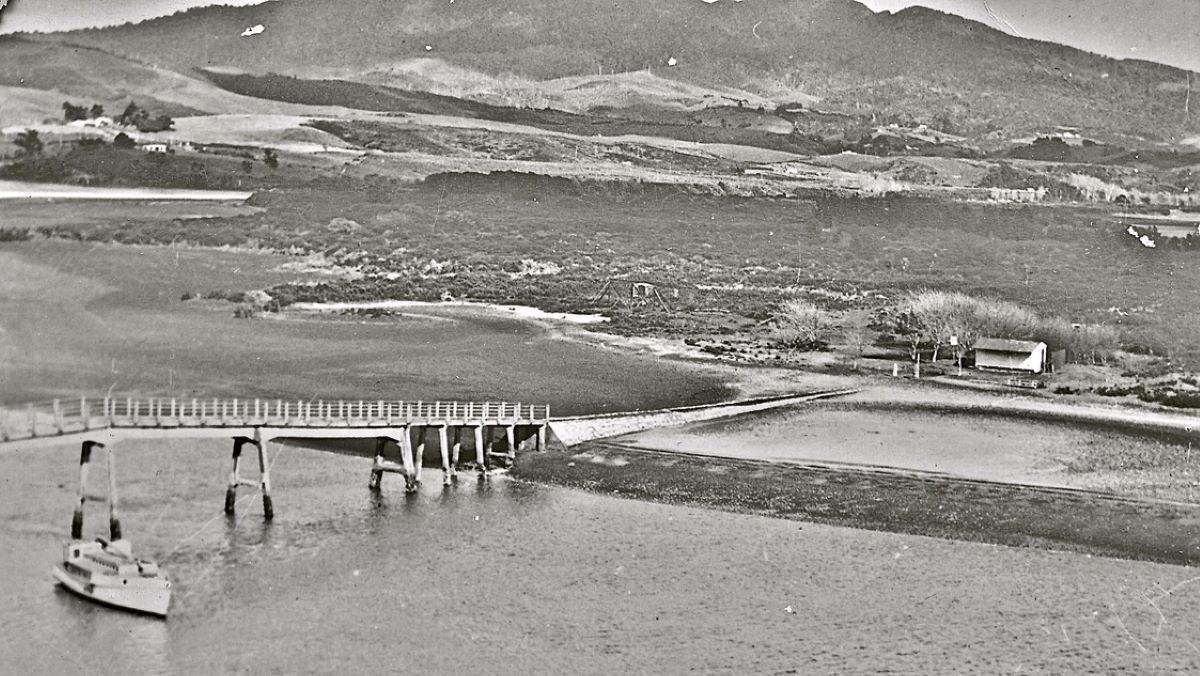Continuing our occasional history series, we look back to Whāingaroa a century ago – 1925
1925 Part 3: The first footbridge to future seaside park
by John Lawson
In February 1925 Raglan Town Board accepted a £2,261 tender from A. Jane, of Hamilton, to build a 320 ft. long, 6ft. wide, reinforced concrete footbridge, on pillars 40ft. apart, with a 15ft. clearance for boats. It had been designed by Thomson & Oliver Robert Farrer, Hamilton. It was explained that, “the difficulty of constructing approaches on the Raglan side and the sandy Domain make vehicular traffic undesirable.” Building temporarily closed the path (now called Pūtoetoe Walkway) from the stone wharf to the bathing sheds (the sheds and a small area enclosed by wire netting had been built as a safe swimming area by the Harbour View Hotel in 1887, when access to the main beaches was only by ferry). Work started in April and the bridge was finished by Christmas. Plans were also mentioned to plant trees on the Domain (described as about 40 acres of sandhills) and develop it as a seaside park.
Although tree planting was going on in town, bush in the country was still being cut and burnt. Hayward Armstrong started a sawmill on Paparata (near the top of Ruapuke Rd) to cut rimu. Charles McAsey, the Raglan Sawmilling Company manager at Te Hutewai, who had been jailed for a week in 1924 for being drunk in charge of a motor car, was sacked in 1925 and a judge found he was incompetent and negligent. In court allegations were made that the company machinery was of poor quality, evidence being given that, “a hauler broke on a not very big log”. That mill burnt down in a bush fire in 1928 and didn’t reopen. It was reported in March 1925 that, “settlers in the Waitetuna district have been burning off their bush in anticipation of the break-up of the weather, and Waitetuna has been under a heavy pall of smoke”. Felling of the bush at the top of the divi started in 1924, but on 10 September 1925 about 15 acres of bush on the northern side of the deviation was made into a scenic reserve by Raglan County.
P. L. Hill, of Three Streams, made nature reports from 1916 to 1941. He noted wekas were everywhere and a few red admiral and small light blue butterflies, but not the white butterflies he knew from Europe; they were first found at Napier in 1930.
However wildlife was in decline, not only from loss of habitat, but also stoats, which had spread to Raglan in the 1890s. In 1925 they were blamed because the “number of feathered game available to sportsmen has become less and less”. Nevertheless, in April 1925 Kawhia Rod & Gun Club decided to find out about introducing possums. By October Waikato hunters had left the Auckland Acclimatisation Society, and there was a strong Raglan Acclimatisation & Game Conservation Club. 5000 rainbow trout were, “liberated in streams flowing into Raglan harbour.” Dr. Saunders cat got in the news by killing a stoat. Dr Roland Cashmore bought the Raglan practice from Dr Saunders and moved from Kawhia in January. He sold to Dr Arthur Beresford Sturtevant in August 1926.
Raglan County lengthened what was then known as the stone wharf, or ferry wharf, by six feet in July, but in September a storm damaged the nearby bank. It had been repaired by November.
To encourage the use of water transit and reduce the damage lorries were doing to its roads, Raglan County reduced the wharfage on wool from 1s to 6d a bale and that on butter was halved to 2s 6d a ton.
The 1898, 412 ton, ss. Rimu (occasionally replaced by Arapawa or Aupouri) was still running a weekly Onehunga-Raglan-Kawhia service. However, Raglan Dairy Company suppliers decreased from 149 to 130, their output was down and in November the Northern Steamship Co met shippers to talk about competition from the railway and say Rimu was running at a loss. Wharf charges weren’t the only problem; “pilfering was going on at wharves everywhere” and Rimu’s captain said he could only cross the Raglan bar at ¾ flood tide and wasn’t sure about entering Kawhia at night as he didn’t know if the beacons would be lit. In July Rimu carried about 150 Kawhia rugby players and supporters to Raglan for their biennial match. Unusually Raglan won. Rimu returned at 9 p.m. and reached Kawhia at about midnight.
On a good day it took about 7 hours for the 140km to Onehunga, but storms delayed 5 trips by up to 3 days. Travellers had to be very flexible; in January Rimu ran a day early, as the waterside workers cancelled their annual picnic, due to the infantile paralysis outbreak.
The other major cargo used to be flax, but by 1925 most flax had gone as land was brought into grass, though the port records show flax continued to be shipped until 1929. Okete Falls flax mill closed in 1925. The power from the Falls was then used to generate electricity for lighting, milking and shearing for over 20 years, until the farm was linked to the mains.
The changes were reflected in the annual port returns. 2,572 tons of cargo came in, but much less went out, mainly wool and butter –
| Year | Wool | Dairy | Hides, Skins, Pelts | Flax | Timber | other goods | Total | Number of ships |
| 1924 | 233 | 204 | 41 | 25 | 229 | 151 | 883 | 48 |
| 1925 | 246 | 196 | 9 | 122 | 103 | 676 | 53 | |
| 1926 | 266 | 263 | 13 | 53 | 125 | 720 | 54 |

